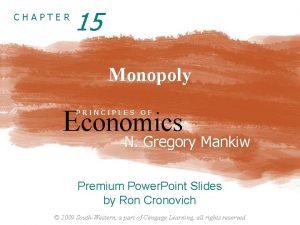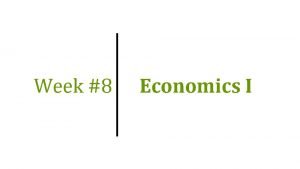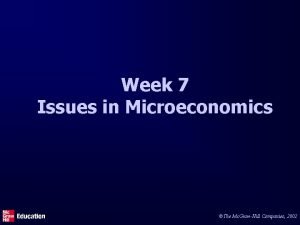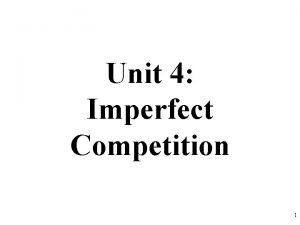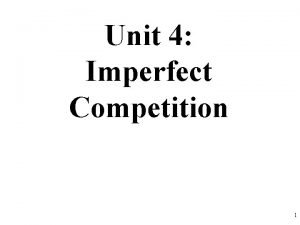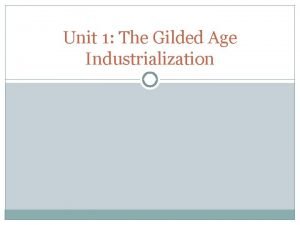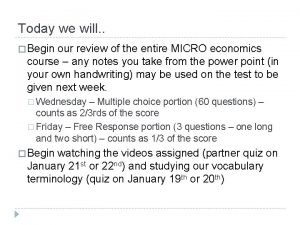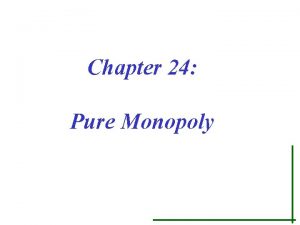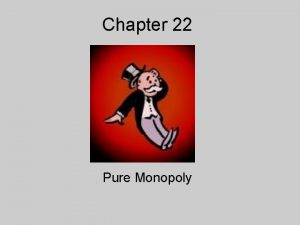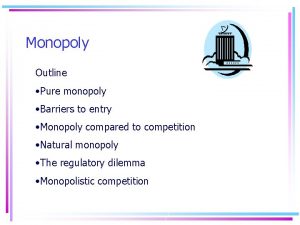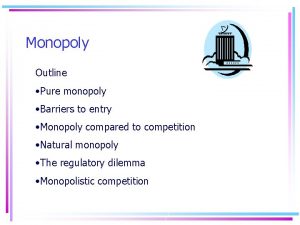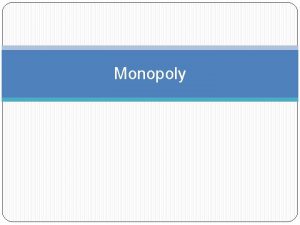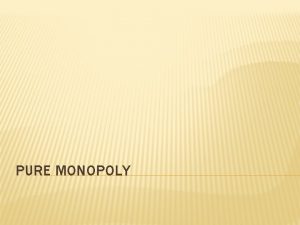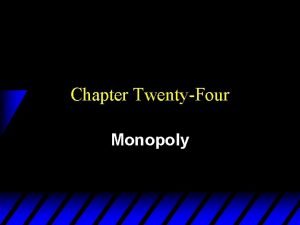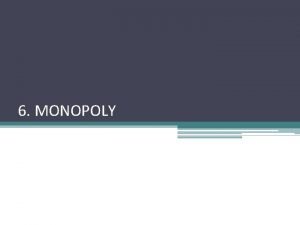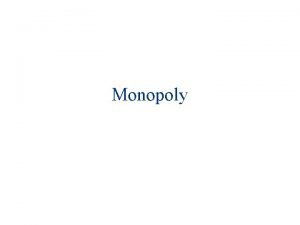Chapter 12 Pure Monopoly Introduction to Pure Monopoly
















- Slides: 16

Chapter 12 Pure Monopoly

Introduction to Pure Monopoly • Pure monopoly • Single seller – a sole producer • No close substitutes – unique product • Price maker – control over price • Blocked entry – strong barriers to entry • Non-price competition – mostly PR but can engage in advertising to increase demand LO 1 12 -2

Barriers to Entry • Barriers to entry are factors that prevent firms from entering the industry • Economies of scale • Legal barriers to entry like patents and licenses • Ownership or control of essential resources • Pricing and other strategic barriers LO 2 12 -3

Economies of Scale Average total cost $20 15 0 LO 2 ATC 10 50 100 Quantity 200 12 -4

Monopoly Demand • The pure monopolist is the industry • Monopolist demand curve is the market demand curve • Demand curve is downsloping • Marginal revenue is less than price LO 3 12 -5

Monopoly Demand • Marginal revenue will be less than price • Monopolist is a price maker • Monopolist sets price in the elastic region of the demand curve LO 3 12 -6

Demand, Marginal Revenue, and Total Revenue Elastic $200 Inelastic Price 150 100 50 0 MR 2 4 $750 Total revenue D 6 8 10 12 Total-revenue curve 14 16 18 500 250 TR 0 LO 3 2 4 6 8 10 12 14 16 18 12 -7

Output and Price Determination Steps for Graphically Determining the Profit-Maximizing Output, Profit. Maximizing Price, and Economic Profit (if Any) in Pure Monopoly Step 1 Determine the profit-maximizing output by finding where MR=MC. Step 2 Determine the profit-maximizing price by extending a vertical line upward from the output determined in step 1 to the pure monopolist’s demand curve. Step 3 Determine the pure monopolist’s economic profit by using one of two methods: Method 1. Find profit per unit by subtracting the average total cost of the profit-maximizing output from the profit-maximizing price. Then multiply the difference by the profit-maximizing output to determine economic profit (if any). Method 2. Find total cost by multiplying the average total cost of the profit-maximizing output by that output. Find total revenue by multiplying the profit-maximizing output by the profit-maximizing price. Then subtract total cost from total revenue to determine the economic profit (if any). 12 -8

Misconceptions Concerning Monopoly Pricing • Not the highest price • Total profit • Possibility of losses LO 4 12 -9

Economic Effects of Monopoly • Income transfer • Cost complications • Economies of scale • Simultaneous consumption • Network effects • X-inefficiency • Rent-seeking behavior • Technological advance LO 5 12 -10

X-Inefficiency Average total costs ATCx ATC 1 X' ATCx' Average total cost ATC 2 0 LO 5 X Q 1 Quantity Q 2 12 -11

Assessment and Policy Options • Antitrust laws • Break up the firm • Regulate it • Government determines price and quantity • Ignore it • Let time and markets get rid of monopoly LO 5 12 -12

Price Discrimination • Price discrimination • Charging different buyers different prices • Different prices are not based on cost differences • Conditions for success • Monopoly power • Market segregation • No resale LO 6 12 -13

Graphical Analysis P P Economic profit Pb Economic profit MC = ATC Qb MC = ATC Ds Qs MRb (a) Small businesses LO 6 Ps Db MRs (b) Students 12 -14

Regulated Monopoly • Natural monopolies • Socially optimal price • Set price equal to marginal cost • Fair return price • Set price equal to average total cost LO 7 12 -15

Monopoly Power in the Internet Age • • Google dominates search Facebook dominates social media Amazon dominates as an online retailer Barriers of entry • Network effects of being large attract more users • Economies of scale 12 -16
 Advantages of monopoly
Advantages of monopoly One major barrier to entry under pure monopoly arises from
One major barrier to entry under pure monopoly arises from Pure competition and monopoly _____
Pure competition and monopoly _____ Monopoly
Monopoly Monopoly economics
Monopoly economics Properties of pure substances
Properties of pure substances Body paragraph structure
Body paragraph structure Deadweight loss in a monopoly
Deadweight loss in a monopoly Social cost of monopoly
Social cost of monopoly Monopoly vs perfect competition
Monopoly vs perfect competition Social optimum quantity
Social optimum quantity Monopoly characteristics
Monopoly characteristics Standard oil monopoly
Standard oil monopoly Lump sum subsidy
Lump sum subsidy Perfect competition vs monopolistic competition
Perfect competition vs monopolistic competition Social cost of monopoly
Social cost of monopoly Monopolistic competition examples
Monopolistic competition examples



